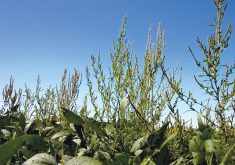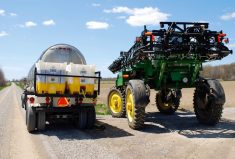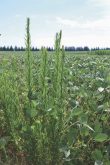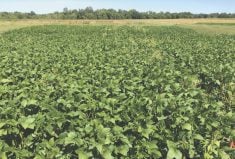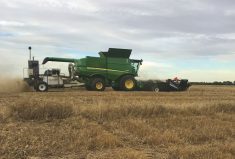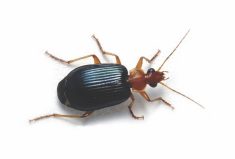Josh Lade has an Australian urge to crush weed seeds into fine powder. Lade, who farms at Osler, Sask., rigged the farm’s combines with Seed Terminator chaff mills so weeds don’t “dictate the way I farm” like they do for farmers in Australia.
Lade grew up on a mixed farm on Kangaroo Island, near Adelaide, Australia. While the farm raised mostly sheep and seed potatoes, “grain cropping was my passion,” he says. Lade studied agriculture at the University of Adelaide and paid close attention while his cousin Nick Berry took the Seed Terminator weed seed destroyer to market.
Australians invented the chaff destroyers out of necessity. Without effective herbicides to control resistant annual ryegrass in cereal crops, weeds “dictated” the rotations for Australian farmers, Lade says. The result was adoption of break crops — canola, lentils, peas and hay — and investment in combine weed seed destroyers.
Read Also

Riding the tariff roller-coaster
What producers are doing to minimize the risk created by ongoing trade uncertainty.
The tow-behind Harrington Seed Destructor led the way, and was later relaunched as an integrated unit. Competitors followed, including Redekop’s Seed Control Unit and Nick Berry’s Seed Terminator. Approximate costs are $90,000 to $120,000. While common in Australia, these tools are just entering the weed management conversation in Canada.
Resistance fighter
This conversation could change from murmur to buzz with the rapid spread of glyphosate-resistant kochia across the Prairies, arrival of glyphosate-resistant waterhemp in Manitoba, and the discovery of glyphosate-resistant downy brome in southern Alberta.
Agriculture and Agri-Food Canada (AAFC) research scientists Charles Geddes in Lethbridge and Shaun Sharpe in Saskatoon survey weeds to track the rise of resistance. Fifty per cent of kochia surveyed in Alberta in 2017 had some degree of glyphosate resistance. That number was 58 per cent in Manitoba in 2018, and 88 per cent in Saskatchewan in 2019. Those numbers are likely to increase in the next round of surveys. On top of that, the Prairies have Group 2-resistant and Group 4-resistant kochia populations — not to mention all the other herbicide-resistant weeds.
Geddes confirmed the glyphosate-resistant downy brome in Alberta after an agronomist reported a population that had survived four applications. “We don’t know if it occurs beyond this one field,” Geddes says. However, the big picture, Sharpe adds, is that further evolution of resistance is a risk “if we don’t start to address this through integrated management.”
Breanne Tidemann, a research scientist at AAFC in Lacombe, Alta., analyzed the performance of weed seed destroyers, including the original tow-behind Harrington Seed Destructor and early prototypes of the Redekop Seed Control Unit. She observed at least a 95 per cent kill rate on seeds that entered the mills, consistent with testing in Australia and the United States. Entering the mill is key. The system works well for cleavers and volunteer canola. “However, wild oats that drop their seeds early can be hard to get in there. Thistles with their parachute pappus float away,” she says. And kochia, which can have a lot of seeds near ground level, could have many harvest escapes unless the crop is cut low.
Even so, combine weed seed destroyers give farmers one last chance to stop weeds that, like Rasputin, survived all previous attempts to kill them. “Herbicide-resistant weeds are the ones that will be in the field at harvest time, so preventing those seed bank additions is a huge thing for managing those populations,” Tidemann says.
As for the sticker price, “if you spread the capital cost of a mill over all of your acres and over how many years you’ll use it, that number starts breaking down quite quickly,” Tidemann says. “If you compare that to what you might lose from herbicide-resistant weeds or how many herbicides you have to spray to control a weed, there are a lot of trade-offs when you do those economic calculations.”
Back at the Lade farm
Josh Lade came to Canada to work on farms in 2009 and 2010. In 2010, he worked with Janice and John Wiebe at Osler. He also met and later married Jeannie from Edmonton, which was a good reason to stay in Canada. In 2013, Josh and Jeannie started a partnership with the Wiebes, and they’ve been farming as a partnership ever since.
The farm, like many, has been “grappling with resistant weeds,” Lade says. He estimates about half of their wild oats are Group 1 resistant. Cleavers and kochia are Group 2 resistant and he suspects — though it isn’t officially confirmed — that some of their kochia is Group 9 resistant. He didn’t want to wait until resistant weeds dictated his crop rotation the way they do in Australia, so he got proactive.
He first tried a low-tech approach to harvest weed seed management, using a home-made chute to guide all chaff into a concentrated row. Then, according to plan, he would go back after harvest and burn those chaff rows. Of course, lighting fires is easy (and a little scary) in the hot and desert-like Australian off-season, which is why Australian farmers are reluctant to use that technique, Lade says. The practice would be less risky in Canada, he figured, with the cold, snowy off-season. “But boy, did we have trouble burning those rows,” he says. So he ditched that idea and, in 2018, bought a Seed Terminator.
It mounts neatly underneath the back end of the combine, and derives power from the slow-speed chopper drive. Inside are hammer mills that “pulverize chaff into flour,” Lade says.
Results have been “promising,” he says. “The most obvious benefit is the reduction in volunteers. Losing just one per cent of canola seeds out the back of the combine is five times the normal seeding rate.” When those seeds are destroyed, the reduced number of volunteers is obvious.
Weed reductions are harder to measure, he says, but the lower seed bank has allowed them to reduce chemical use. “We can usually get by with one pass instead of two passes in canola,” he says, “and without as many wild oats in cereals, we can get by with one spray before the crop and only patch sprays in the crop.”
Like Tidemann, Lade has observed clear limitations: Some weed seeds shell out ahead of harvest. Some are below the cut height. And some exit the combine with the straw, not the chaff. To remedy these effects to some extent, Lade cuts lower in weedy patches and fine-tunes combine settings to thresh weeds as well as crop.
Like Australian farmers, Lade integrates a diverse crop rotation with his herbicide sprays and Seed Terminator. The farm grows five or six different crops — wheat, canola, barley, oats and pulses — to add diversity in crop competition and in-crop herbicide options.
The twist here is that Lade adopted these practices before he had to. Australian farmers were desperate for new solutions because herbicide-resistant weeds dictated a change. Lade didn’t have his back against the wall, but he bought a Seed Terminator and added crop diversity anyway. He saw a looming problem and wanted to be proactive.
At the end of the day, the advanced weed management practices improved the bottom line for all involved. Lentils and export hay became some of the more profitable crops for Australian farmers, Lade says. “The change turned out well for them, even though they had to do it. For us, we took a proactive approach and are also making good returns.”
Integrated weed management — tools and techniques
Weed seed destroyers can be an effective part of a complete integrated weed management program. Here is a full list of tools and techniques:
1. Make the crop more competitive.
Use higher seeding rates, varied seeding dates, shallow seeding depth, narrow row spacing, and taller crops. Also, use seed treatment and place fertilizer into the soil where seeded crop has easier access.
2. Take a whole-rotation approach.
A diverse rotation allows for different in-crop herbicide options. A diverse rotation that includes crops that are more competitive, grow taller, have winter or perennial seasons, or varying harvest times provides more competition against weeds.
3. Scout each field before and after herbicide application. A pre-application scout will identify the weeds present and their stage. This will determine what tank mix to use and the herbicide rate required. Two weeks after spraying, check the field again to identify escapes or next flushes. What weeds are not controlled, and why? If escapes are in a small patch, spot spraying, mowing or hand weeding may be the best way to get rid of them before they set seed.
4. Tank mix herbicides from different groups. Make sure more than one herbicide in the mix is effective on the target weeds.
5. Improve herbicide efficacy. Follow herbicide labels for timing, rates and water volumes as well as weather restrictions (frost, rain, heat) that may reduce efficacy. Early control is an important step, as herbicides are more effective on small weeds. Also check water quality. Hard water reduces glyphosate, glufosinate and 2,4-D amine efficacy.
6. Clean equipment. Keep farm equipment clean so weeds are not spread from field to field or from one farm to another.
7. Consider spot tillage. No till depends on effective herbicides. In some cases, spot tillage or strategic tillage may be required to protect the usefulness of those herbicides essential to a no-till or reduced-tillage system.
8. Invest in harvest weed seed control. Methods include burning narrow chaff rows and seed pulverization with combine weed seed destroyers.
9. Keep records. What weeds are in each field? What products were sprayed and other techniques used? Keep track of agronomy practices that may influence weed management and crop competition.



